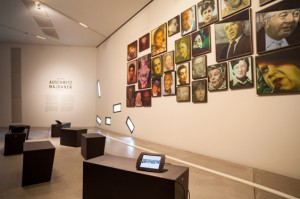
Area on the Majdanek Trial in the permanent exhibition
© Jewish Museum Berlin, photo: Alexander Zuckrow
Forty-four portraits have been mounted in the permanent exhibition over the last few weeks. They are a series of paintings by Minka Hauschild, called “Majdanek Trial Portraits,” and they show the participants of the Majdanek Trial, that took place at the regional court in Dusseldorf from 26 November 1975 until 30 June 1981. Standing in front of the wall of portraits, viewers are left to wonder: “Who is who, here?” The paintings themselves don’t reveal whether the subject was a former prisoner or an SS officer. Some portraits are realistic, but others seem distorted or blurred to the point of being unrecognizable. All of the people portrayed appear to have been damaged in some way. The portraits are deeply disturbing.
Our visitors can find out on iPads lying on the benches nearby whether a given painting depicts a judge, a lawyer for the defense, a witness, or a defendant. Each individual’s role in the Majdanek trial is described here and insight is provided into their biography as well as – where the sources permit – their own perception of the proceedings.
The “Majdanek Trial Portraits” and the accompanying iPad texts convey the history of a trial that was noted by contemporary witnesses for being “horrifying.” Sixteen members of the guard personnel, among them six women, sat in the dock. Four were acquitted in 1979 for lack of proof that they had personally participated in murder. The trial’s final verdicts in 1981 came across as mild. The court only recognized the defendant Hermine Braunsteiner-Ryan as a willful perpetrator in her own right, and sentenced her on the count of murder to life in prison. Several witnesses made statements that she dragged or threw toddlers and infants onto the trucks that brought them to their deaths in the gas chambers.
Minka Hauschild’s painting cycle reflects the long reverberation that the trial had in the media, society at large, and in the arts. She created it in 1995 and 1996, twenty years after the trial began. The artist was inspired primarily by the documentary film The Trial, a four and a half hour report first aired on public television in 1984, which was viewed by millions. It’s based on conversations with a number of participants in the trial, and assembles their opposing perspectives into a mesmerizing collage of interviews. The painter was so fascinated by the pictures of the faces of the defendants, witnesses, lawyers, and observers at the trial, that she photographed them on the television screen and used the photographs as a basis for her oil portraits.
The Majdanek trial is the longest court proceeding in German legal history. The discrepancy between the sentences given and the crimes described at the trial illustrates the inability of the West German system of justice to find an appropriate way to deal with Nazi atrocities. The “Majdanek Trial Portraits” show that this proceeding (like the Auschwitz Trial) continues to have an effect many years after the judgments were handed down.
Monika Flores Martínez, Permanent Exhibition
